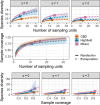Medicinal plants trade in Harare's urban markets: diversity, conservation status, and economic significance
- PMID: 40275311
- PMCID: PMC12023468
- DOI: 10.1186/s13002-025-00778-0
Medicinal plants trade in Harare's urban markets: diversity, conservation status, and economic significance
Abstract
Background: Urban markets serve as crucial centres for trading traditional medicinal plants, yet there is limited research on the diversity, geographic origins, and socio-economic contributions of these plants. Therefore, this study aimed at understanding the species composition and diversity, conservation status, and economic importance of medicinal plants in urban markets of Harare, Zimbabwe, to provide insights into their sustainability and cultural significance.
Methods: This study surveyed medicinal plant vendors in three major urban markets in Harare, Mbare, Highfield, and the Central Business District (CBD) in 2019 over a period of three months. Data were collected through semi-structured questionnaires to inventory medicinal plant species, document vendors' districts of origin, and assess harvesting practices. Species diversity was analysed using Shannon-Wiener and Simpson diversity indices, while Non-metric Multidimensional Scaling (NMDS) was used to compare species composition across markets. The informant consensus factor (ICF) was calculated to determine the level of agreement among vendors on the medicinal use of plant species.
Results: A total of 64 medicinal plant species were identified, with Fabaceae being the most represented family. Sixty-one species were in the least concern IUCN Red List category. Key species with high use reports included Entada goetzei (62), Cassia abbreviata (58), Pterocarpus angolensis (40), and Albizia anthelmintica (31). Roots were the most sold plant part, followed by bark and leaves. Mbare exhibited the highest species richness (54), followed by Highfield (34), while the CBD recorded the lowest richness (23). Non-metric Multidimensional Scaling (NMDS) analysis revealed distinct differences in species composition among the three markets (R = 0.492), with Highfield displaying a unique suit of medicinal plant species. Vendors primarily originated and sourced their medicinal plants from eastern Zimbabwe, particularly Chipinge, highlighting a strong link between plant sourcing and geographic origin. The ICF was highest for gastrointestinal disorders (0.807), women's health (0.778), sexually transmitted infections (0.746), and labour-related ailments (0.842). Medicinal plant trade contributed significantly to vendors' livelihoods, with monthly incomes ranging from US$150 to $300.
Conclusion: This study underscores the high diversity of medicinal plants and their socio-economic importance in Harare's urban markets. This shows that traditional medicine is still considered important in primary health care in the city of Harare. However, the reliance on distant districts (~ ≥ 100 km) for plant sourcing raises concerns about the possibility of unknowingly overharvesting.
Keywords: Diversity; Harare; Informant consensus factor; Medicinal plants; Public markets; Use report.
© 2025. The Author(s).
Conflict of interest statement
Declarations. Ethics approval and consent to participate: The study was granted a human ethics approval by the Ministry of Local Government of Zimbabwe through the City of Harare Municipality. The municipality assessed the proposal and tools for the study and certified that the study was performed in accordance with the ethical standards as laid down in the 1964 Declaration of Helsinki and its later amendments. Prior informed consent to being interviewed and for the work to be published was granted by all the interviewees. Participants provided verbal consent before taking part in interviews. Additionally, they consented to the use of their individual data for publication. Consent to Publication: Not applicable. Competing interests: The authors declare no competing interests.
Figures






Similar articles
-
Medicinal plants sold at traditional markets in southern Ecuador.J Ethnobiol Ethnomed. 2016 Jul 5;12(1):29. doi: 10.1186/s13002-016-0100-4. J Ethnobiol Ethnomed. 2016. PMID: 27380631 Free PMC article.
-
Volume, value and floristic diversity of Gabon׳s medicinal plant markets.J Ethnopharmacol. 2014 Sep 11;155(2):1184-93. doi: 10.1016/j.jep.2014.06.052. Epub 2014 Jul 1. J Ethnopharmacol. 2014. PMID: 24995835
-
Ethnobotanical study of traditional medicinal plants used by the local people in Habru District, North Wollo Zone, Ethiopia.J Ethnobiol Ethnomed. 2024 Jan 4;20(1):4. doi: 10.1186/s13002-023-00644-x. J Ethnobiol Ethnomed. 2024. PMID: 38178202 Free PMC article.
-
An overview on ethnobotanico-pharmacological studies carried out in Morocco, from 1991 to 2015: Systematic review (part 1).J Ethnopharmacol. 2021 Mar 1;267:113200. doi: 10.1016/j.jep.2020.113200. Epub 2020 Aug 1. J Ethnopharmacol. 2021. PMID: 32750461
-
Richness of non-timber forest products in Himalayan communities-diversity, distribution, use pattern and conservation status.J Ethnobiol Ethnomed. 2020 Sep 23;16(1):56. doi: 10.1186/s13002-020-00405-0. J Ethnobiol Ethnomed. 2020. PMID: 32967686 Free PMC article. Review.
References
-
- Urso V, Signorini MA, Tonini M, Bruschi P. Wild medicinal and food plants used by communities living in Mopane woodlands of southern Angola: Results of an ethnobotanical field investigation. J Ethnopharmacol. 2016;177:126–39. - PubMed
-
- Kunwar RM, Mahat L, Acharya RP, Bussmann RW. Medicinal plants, traditional medicine, markets and management in far-west Nepal [Internet]. 2013. Available from: http://www.ethnobiomed.com/content/9/1/24 - PMC - PubMed
-
- Williams VL, Witkowski ETF, Balkwill K. The use of incidence-based species richness estimators, species accumulation curves and similarity measures to appraise ethnobotanical inventories from South Africa. Biodivers Conserv. 2007;16:2495–513.
-
- Botha J, Witkowski ETF, Shackleton CM. The impact of commercial harvesting on Warburgia salutaris (‘pepper-bark tree ’) in Mpumalanga. South Africa Biodivers Conserv. 2004;13:1675–98.
-
- Cunningham A. An Investigation of the herbal medicine trade in Natal/ KwaZulu. 1988.
MeSH terms
LinkOut - more resources
Full Text Sources

